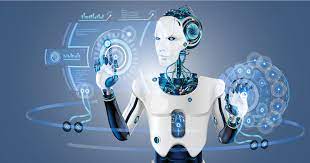Robotic Process Automation (RPA)
Blog Credit : Trupti Thakur
Image Courtesy: Google
What is robotic process automation?
Robotic process automation (RPA) is a software technology that makes it easy to build, deploy, and manage software robots that emulate humans’ actions interacting with digital systems and software. Just like people, software robots can do things like understand what’s on a screen, complete the right keystrokes, navigate systems, identify and extract data, and perform a wide range of defined actions. But software robots can do it faster and more consistently than people, without the need to get up and stretch or take a coffee break.
Robotic Process Automation (RPA) is software technology that’s easy for anyone to use to automate digital tasks. With RPA, software users create software robots, or “bots”, that can learn, mimic, and then execute rules-based business processes.
What are the business benefits of RPA?
Robotic process automation streamlines workflows, which makes organizations more profitable, flexible, and responsive. It also increases employee satisfaction, engagement, and productivity by removing mundane tasks from their workdays.
RPA is noninvasive and can be rapidly implemented to accelerate digital transformation. And it’s ideal for automating workflows that involve legacy systems that lack APIs, virtual desktop infrastructures (VDIs), or database access.
Robotic Process Automation (RPA) brings the image of physical robots performing labor-intensive activities, like cleaning a house, lifting heavy objects, doing every work as a human worker.
RPA is used in most industries, particularly those that include repetitive tasks such as insurance, banking, finance, healthcare and telecommunications. RPA is used in finance to automate governance, reconcile accounts or process invoices.
The best RPA solution is UIPath, which offers a wide range of simple-to-use robot features, including artificial intelligence, and scales according to your business demands.
3 Main Main Types Of Robotic Process Automation (RPA)
There are 3 main types of robotic process automation:
- Attended automation
- Unattended automation,
- Hybrid RPA.
- Attended Robotic Process Automation (RPA): Attended RPA bots are like virtual assistants, helping an individual employee with their tasks to boost productivity. Legacy Attended Automation is confined to a single employee’s desktop. Unattended RPA bots run automation that works on its own.
An example of attended RPA is when a customer service specialist activates a bot to execute an address change request in a matter of seconds instead of making the updates manually, which could involve a number of steps and clicks.
The Advantages of Attended RPA Bots
- Agile and user-friendly.
- Eliminates real-time data entry tasks.
- Improves team efficiency and productivity.
- Increases customer satisfaction.
- Requires minimal setup, and the deployment is quick and straightforward.
- Achieves ROI quickly.
- UnAttended Robotic Process Automation (RPA): Unattended RPA bots run automation that works on its own. The aim for many business processes is end-to-end automation, where bots are enabled to execute entire processes independently. Assists with front-office tasks by collaborating with employees and teams.
Robotic process automations (RPA) are “unattended” when they run independently without human input. The automation can perform tasks any time of the day for an unlimited amount of time without relying on help from a user. These processes run in the background as they trigger and complete tasks automatically.
Unattended bots handle repetitive, frequent and simple processes. These are the tasks that can break down into step-by-step rules. They need to happen repeatedly or on a mass scale but completing them is formulaic. For example, think manual data entry, email management, repetitive admin, monitoring, and so on.
Here are some other significant advantages of unattended bots.
- Self-triggered and can work without human intervention.
- Works 24×7, 365 days a year.
- Modifies functions in real-time.
- Deploys, schedules, and audits operations.
- Effectively gathers, sorts, and analyses data.
- Reduces operating costs.
- Eliminates errors.
- Hybrid Robotic Process Automation: Hybrid robots are a combination of attended and unattended robots that provide user support and back-end processing in a single solution that moves closer to the potential of the end-to-end automated execution of complex business workflows such as invoice processing.
Hybrid automation is most often used for customer-facing tasks, such as customer services, call centers, and hotels, to optimize repetitive tasks and create more time for users to cater to their customers’ needs.
An Example of Hybrid RPA is- hybrid automation is used for client and prospect management. The RPA bot creates a contact information list of potential leads to input CRM. For the missing contacts, the tool also searches on the internet for further contact information of the potential client.
Here are some Significant Advantages of Hybrid Bots
- Customer satisfaction. As hybrid automation is often used in customer-facing roles, eliminating repetitive tasks enables customer service employees to work more efficiently
- An optimized mix of human intervention vs automation.
- Increased automation scope.
Future Of Robotic Process Automation
There are so many opportunities in the RPA sector. A career in RPA is the best option for you if you want to work in a skill-based industry. According to Indeed, there are so much growth in this industry with highly paid jobs and career satisfaction.
Global robotic process automation (RPA) software end-user spending is projected to reach $2.9 billion in 2022, an increase of 19.5% from 2021, according to the latest forecast from Gartner, Inc.
According to the report by McKinsey & Company, it is predicted that RPA will have a significant economic impact of nearly $5.2 to $6.7 trillion by 2025.
Blog By: Trupti Thakur

10
FebRobotic Process Automation (RPA)
Feb 10, 2023Recent Blog
Vikram 3201 & Kalpana 3201Apr 04, 2025
The Open Weight Language ModelApr 03, 2025
Asia Cup 2025Apr 02, 2025
The CrocodilusApr 01, 2025
SARATHIMar 31, 2025




